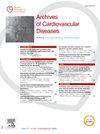多巴酚丁胺应激超声心动图中壁运动分析、冠状动脉血流储备及心肌灌注分析的可行性
IF 2.2
3区 医学
Q2 CARDIAC & CARDIOVASCULAR SYSTEMS
引用次数: 0
摘要
2024年ESC指南强调了心肌灌注(1类,B级)和冠状动脉血流储备(CFR) (2b类,B级)在应激超声心动图中的重要性。然而,这些药物在法国仍未得到充分利用,可能是由于多巴酚丁胺的主要使用。本研究评估在多巴酚丁胺应激超声心动图中CFR和心肌灌注评价的可行性。目的评价多巴酚丁胺应激超声心动图测量CFR及心肌灌注的可行性。方法为期3年的单中心开放介入研究。所有连续接受多巴酚丁胺应激超声心动图检查的患者均纳入研究。试验按照EAE指南进行。Sonovue®造影剂用于心肌灌注。CFR以左前降支(LAD)舒张峰值速度与静息速度之比计算。峰值应激前用Flash/Replenishment法评估心肌灌注。结果196例患者(平均年龄71岁,男性56%),97%达到目标心率。CFR测量90%可行,心肌灌注98%可行(评估≥80%的心肌节段)。三模态评估(壁运动、CFR和心肌灌注)的成功率为90%(图1)。中位CFR为2.55,在LAD区域壁运动异常患者中较低(2.00,图2),而左心室功能障碍患者中CFR更低(1.61,图2,图3)。结论多巴酚丁胺应激超声心动图中综合WMA、CFR和心肌灌注的多参数方法是可行的。CFR测量在90%是可行的,心肌灌注在98%是可行的,尽管有小的衰减伪影。局部壁运动异常和左室功能障碍患者的CFR较低,提示与心肌缺血密切相关。这支持了CFR在改善缺血评估方面的作用,而不仅仅是壁运动分析。需要进一步的研究来评估其诊断作用。本文章由计算机程序翻译,如有差异,请以英文原文为准。
Feasability of wall motion analysis plus coronary flow reserve, and myocardial perfusion analysis during dobutamine stress echocardiography
Background
The 2024 ESC guidelines highlights the importance of myocardial perfusion (class 1, level B) and coronary flow reserve (CFR) (class 2b, level B) in stress echocardiography. However, these remain under-utilized in France, likely due to the predominant use of Dobutamine. This study assesses the feasibility of CFR and myocardial perfusion evaluation during Dobutamine stress echocardiography.
Objectives
To assess CFR measurement and myocardial perfusion feasibility during Dobutamine stress echocardiography.
Methods
Three years monocentric open interventional study. All consecutive patients receiving Dobutamine stress echocardiography were included. The test was performed following EAE guidelines. Sonovue® contrast was used for myocardial perfusion. CFR was calculated as the ratio of peak to resting diastolic velocity in the left anterior descending (LAD) artery. Myocardial perfusion was assessed using the Flash/Replenishment method before peak stress.
Results
Among 196 patients (mean age 71 years, 56% men), the target heart rate was achieved in 97%. CFR measurement was feasible in 90%, and myocardial perfusion in 98% (assessing ≥ 80% of myocardial segments). Triple modality assessment (wall motion, CFR, and myocardial perfusion) was successful in 90% (Fig. 1). Median CFR was 2.55, lower in patients with wall motion abnormalities in the LAD territory (2.00, Fig. 2), and even lower in left ventricular dysfunction (1.61, Figure 2, Figure 3).
Conclusion
A multiparametric approach integrating WMA, CFR, and myocardial perfusion during Dobutamine stress echocardiography is highly feasible. CFR measurement was feasible in 90%, and myocardial perfusion in 98%, despite small attenuation artifacts. The lower CFR in patients with regional wall motion abnormalities and LV dysfunction suggests a strong link with myocardial ischemia. This supports CFR's role in refining ischemia assessment beyond wall motion analysis alone. Further studies are needed to evaluate its diagnostic impact.
求助全文
通过发布文献求助,成功后即可免费获取论文全文。
去求助
来源期刊

Archives of Cardiovascular Diseases
医学-心血管系统
CiteScore
4.40
自引率
6.70%
发文量
87
审稿时长
34 days
期刊介绍:
The Journal publishes original peer-reviewed clinical and research articles, epidemiological studies, new methodological clinical approaches, review articles and editorials. Topics covered include coronary artery and valve diseases, interventional and pediatric cardiology, cardiovascular surgery, cardiomyopathy and heart failure, arrhythmias and stimulation, cardiovascular imaging, vascular medicine and hypertension, epidemiology and risk factors, and large multicenter studies. Archives of Cardiovascular Diseases also publishes abstracts of papers presented at the annual sessions of the Journées Européennes de la Société Française de Cardiologie and the guidelines edited by the French Society of Cardiology.
 求助内容:
求助内容: 应助结果提醒方式:
应助结果提醒方式:


